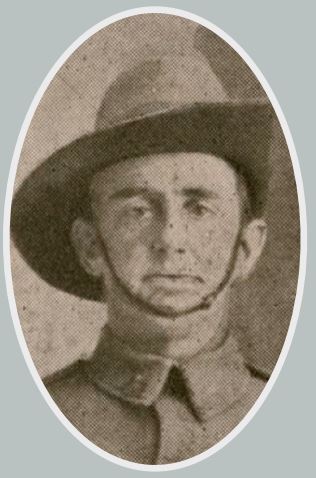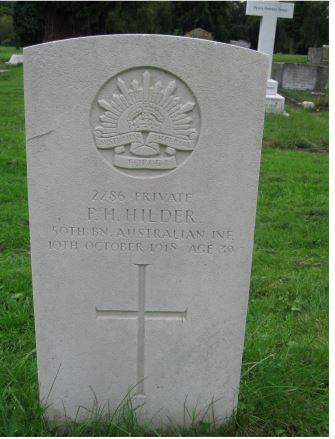50th Battalion, Australian Infantry

Percy Howard Hilder was born and died in England but fought with the Australian Army.
He was born in the St Pancras area of London in the third quarter of 1893, the son of Alfred and Elizabeth Hilder and was baptised in Tottenham on 20 January 1880. According to the 1881 Census the couple had six children. No trace can be found of the family in the 1891 Census, so presumably they had emigrated to Australia by that date.
Percy enlisted at Charters Towers, Queensland (a gold mining area 800 miles north of Brisbane) on 16 February 1916, at the age of 36 years and eight months. He stated his occupation to be a miner. He was married to Marion Hilder and the couple appear to have had two sons, born in 1906 and 1908 respectively. The family home was Charters Towers Post Office, Charters House, Queensland.
After an initial period of training he embarked from Brisbane on 16 August 1916 on board the HMAT Boorara bound for England and destined to be a re-enforcement for the 50th Battalion, Australian Infantry. The ship arrived in Plymouth on 13 October 1916 and he arrived at No 3 Command Depot, Wool on 14 October 1916.
On 12 December 1916 the SS Arundel sailed from Folkestone with re-enforcements for the Australian Infantry and on the 17th Private Hilder was at the Base Training area of Etaples. Two days later he was taken onto the strength of 52nd Battalion (part of 13 Brigade, 4th Division), at Etaples.
In June 1917 the battalion was engaged in the Ypres Salient and on the 7th was at Neuve Eglise. Here Hilder sustained a slight injury to his hand and he spent time at 11th Casualty Clearing Station before moving on to 58 Scottish General Hospital at St Omer on 8th June. On 5 July he was released to the Convalescence Depot at Boulogne, moving to Rest Camp on the 22nd and finally to 4 Australian Divisional Base Depot on the 25th. He finally rejoined the 52nd Battalion on 7 September. He went on leave to the UK between 29 December 1917 and 19 January 1918.
By September 1918 the Allied Armies were on the advance and pushing the Germans back to their
Hindenburg (or Siegfried) Line defences. On 13 September the 50th Battalion was in action at Vendelles, near Vermand, north west of Peronne. Private Hilder suffered a gun shot wound in his lower left leg and was passed down the line from 12 Australian Field Ambulance, through 5 Casualty Clearing Station to 6th General Hospital at Rouen, where he arrived on 25 September. It would appear that it was found necessary for his foot to be amputated there. This action might have been taken to arrest the spread of gangrene, in order to save the remaining part of his leg.
On 1 October 1918 he was evacuated to England on board the Hospital Ship Guildford Castle. His record indicates that he was admitted to a VAD Hospital in Cheltenham, however, it is possible that he went direct to the Red Cross Hospital at Gloucester (his name is included in a list of men admitted to that hospital on 2 October, published in the Gloucester Journal of 5 October 1918). Evidently his stump was healthy but overall, he was in a low condition and experiencing breathing difficulties on admission. He died on 10 October 1918, aged 39, of acute pneumonia and was buried, four days later, with full military honours, in Gloucester Old Cemetery. His grave now has a CWGC headstone.
He left behind a widow and two young sons. In the early 1920s his wife made enquiries of the Australian Army authorities if there was any financial support available for her to travel to England to see the grave. There was nothing official but a certain charitable organisations did make grants. It is not known if her wish was fulfilled.

Researched by Graham Adams 6 April 2014 (revise
(Photo: www.ww1austburialsuk.weebly.com)
